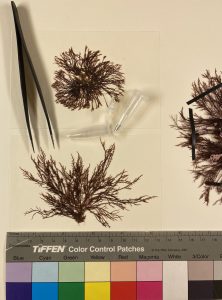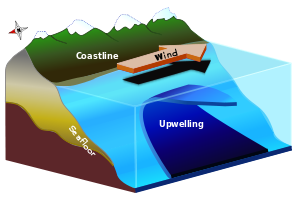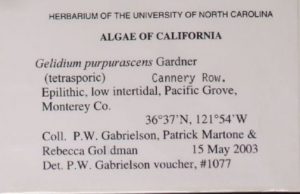As one of the largest herbaria in the southeastern United States, the University of North Carolina at Chapel Hill Herbarium (NCU) loans thousands of specimens to researchers around the world every year. If a botanist is describing a new species, she will need to compare it to closely related plants, so Loan Manager Shanna Oberreiter will pull specimens, package them securely, and send the boxes via the mail. If a researcher is interested in the range of a species and does not need to examine minute physical details on each herbarium specimen, we can do an “electronic loan” and provide the database records and digital images for their project. Sometimes we get more unusual requests.
In September 2019 Dr. Emily Miller wrote, “I am a researcher at the Monterey Bay Aquarium and we are doing a study using historical pressed macroalgae (Gelidium spp.) from Pacific Grove, California to look at changing ocean conditions over time. We have sampled the GM Smith Collection at Stanford’s Hopkins Marine Station and have approximately fifty specimens from 1892-present. However, we have some gaps in our timeline. I saw that there are some specimens in the UNC-Chapel Hill Herbarium that would fill these gaps… We are conducting stable isotope analyses and that requires >50 milligrams of tissue per sample. We understand the irreplaceable nature of these collections and have had success doing this with the Hopkins Herbarium. Paul Gabrielson collected several samples of Gelidium spp. from the area in 2003… We would be interested in a sample from each of these specimens if possible. Our overall aim is to show the value of herbaria in recording global ocean change.”

Shanna and I pulled the algal specimens from the herbarium cases on the first floor of Coker Hall, and Dr. Paul Gabrielson, Herbarium Associate, used clean tweezers to nip off small bits of the algae from five herbarium specimens, then mailed the small tubes with the algae bits to Dr. Miller in California.
In October 2020 I was pleased that Dr. Gabrielson let me know that the results of the study had been published in a paper entitled “Herbaria macroalgae as a proxy for historical upwelling trends in Central California.” 1
Since Dr. Miller and her co-authors can describe their research better than I can, I will quote extensively (text in bold) from their paper for the rest of this column
Long-term environmental records are critical for understanding natural variability, establishing informed ecological baselines and designing effective management strategies. Coastal environments have seen dramatic ecological changes over the last 150 years; however, much of this period is scientifically undocumented. Marine organisms may fill important data gaps and extend time series, as numerous and diverse taxa archive environmental conditions within their tissues, recording an ‘ocean memory’. As a result, natural history repositories of marine algae, foraminifera2, corals, birds, reptiles and other taxa may facilitate reconstruction of historical environmental conditions to complement and extend instrument records.
Macroalgae herbarium collections provide long-term ocean records from the nineteenth century in most of Europe and North America or even centuries earlier in Germany and Italy. In the Victorian era, in western Europe and North America, scientists as well as the middle class public became fascinated by pressing seaweeds. People began collecting intricate and diverse species for artistic personal collections and scientific institutional collections. Many of these herbaria are still present and active today, though there are underused in research and continued systematic collecting for regional floras is underfunded.
… we used archived specimens of one focal genus [Gelidium] from multiple herbarium collections to examine changing coastal ocean conditions over 140 years in Monterey Bay, California… along a linear 6 km coastline from Point Pinos, Pacific Grove to Cannery Row, Monterey.
———-
At this point in reading Dr. Miller’s paper, I had to stop and consult the Scholars’ Tool of Choice (Wikipedia) to educate myself about “upwellings”,δ 15N, and the “Bakun index,” which much to my surprise did not have anything to do with the ratio of bread to bacon on a Merritt’s BLT… but should.3

“Upwelling is an oceanographic phenomenon that involves wind-driven motion of dense, cooler, and usually nutrient-rich water from deep water towards the ocean surface, replacing the warmer, usually nutrient-depleted surface water. The nutrient-rich upwelled water stimulates the growth and reproduction of primary producers such as phytoplankton… The increased availability of nutrient in upwelling regions results in high levels of primary productions and thus fishery production. Approximately 25% of the total global marine fish catches come from five upwellings that occupy only 5% of the total ocean area… Worldwide, there are five major coastal currents associated with upwelling areas: the Canary Current (off NW Africa), the Benguela Current (off southern Africa), the California Current (off California & Oregon), the Humboldt Current (off Peru & Chile), and the Somali Current (off Somalia & Oman). All of these currents support major fisheries.”5
“Given the ecological importance of upwelling, indices designed to monitor its intensity (e.g., the “Bakun Index”) were introduced nearly 50 years ago.”4
“δ 15N is a measure of the ratio of the two stable isotopes of nitrogen, 15N:14N.”6
———-
Back to Dr. Miller’s paper…
Multiple herbaria [including NCU!] provided Gelidium (Rhodophyta) samples collected in southern Monterey Bay from 1878 to 2018. We examined environmental relationships and found δ 15N correlated with the Bakun upwelling index, the productivity regime of this ecosystem, from 1946 to 2018. Then we hindcasted the Bakun index using its derived relationship with Gelidium δ 15N from 1878 to 1945. This hindcast provided new information, observing an upwelling decrease mid-century leading to the well-known sardine fishery crash.
Upwelling processes dominate the Monterey Bay nutrient regime. The hindcast decrease in upwelling (1937-1945) supports the previously estimated long-term declines in upwelling and primary production from approximately 1920-1950 with the so-called ‘sardine’ regime. These trends were associated with the peak in sardine catch through the 1930’s and into the early 1940s followed by a crash from 1945 to 1950 as the system shifted to an upwelling-favorable, anchovy-dominant regime. This crash resulted in the demise of the Monterey cannery industry… Gelidium spp. therefore appear to be recording the upwelling and primary productivity processes of the larger Monterey Bay ecosystems.
———-

At this point in reading Dr. Miller’s paper, I resolve to re-read Cannery Row by John Steinbeck, as well as The Sea of Cortez by John Steinbeck and Ed Ricketts.
———-
Miller and her co-authors conclude:
Marine macroalgal specimens preserved in herbaria archives can provide a historical account of ocean conditions that precedes instrument records. The important Bakun upwelling index records for the California Current begin in 1946, and this timeline can be extended 70 years using isotopic analysis of Gelidium specimens… Our results provide further justification for active, systematic collecting and archiving of marine macroalgae in herbaria. Higher resolution collections than we had available would allow examining of interacting environmental trends across multiple scales. Our time series from 1878 to 2018 has large gaps based on political and social factors — limited macroalgae collection during World War I, the Depression, World War II and the 1950s, and the last four decades following the concerted effort by a few dedicated marine botanists… Herbaria are critical to documenting environmental changes where instrumentation cannot, and recording how these changes directly affect living organisms, their shifting ranges and community interactions. Such macroalgae collections are underused and underfunded resources housed across the world’s institutions. Maintaining herbaria is vital to advancing techniques to unlock long-term oceanographic data from archived macroalgal tissues and to developing management strategies to conserve coastal resources.

SOURCES and NOTES:
1. Miller, Emily A., Lisin, Susan E., Smith, Celia M., Van Houtan, Kyle S. 2020. Herbaria macroalgae as a proxy for historical upwelling trends in Central California. Proc. R. Soc. B 287: 20200732. http://dx.doi.org/1031098/rspb.2020.0732
2. “Foraminifera (Latin for “hole bearers”) are single-celled organisms, members of a phylum or class of amoeboid protists characterized by streaming granular ectoplasm for catching food and other uses; and commonly an external shell (called a “test”) of diverse forms and materials… Most foraminifera are marine, the majority of which live on or within the seafloor sediment (i.e., are benthic), while a smaller number float in the water column at various depths (i.e., are planktonic).” Wikipedia contributors, ‘Foraminifera’, Wikipedia, The Free Encyclopedia, 2 November 2020, 13:14 UTC, <https://en.wikipedia.org/w/index.php?title=Foraminifera&oldid=986696776> [accessed 2 November 2020]
3. https://www.merrittsblt.com/ If you have never eaten a biscuit from Sunrise nor a BLT from Merritt’s you cannot truly say you have lived in Chapel Hill.
4. Jacox, Michael G., Christopher A. Edwards, Elliott L. Haxen, and Steven J. Bograd. 2018. Coastal upwelling revisited: Ekman, Bakun, and improved upwelling indices for the U.S. West Coast. Journal of Geophysical Research: Oceans. 123(10): 7332-7350.
5. Wikipedia contributors, ‘Upwelling’, Wikipedia, The Free Encyclopedia, 30 September 2020, 03:44 UTC, <https://en.wikipedia.org/w/index.php?title=Upwelling&oldid=981074926> [accessed 2 November 2020]
6. Wikipedia contributors, ‘Δ15N’, Wikipedia, The Free Encyclopedia, 19 October 2020, 05:15 UTC, <https://en.wikipedia.org/w/index.php?title=%CE%9415N&oldid=984269146> [accessed 2 November 2020]